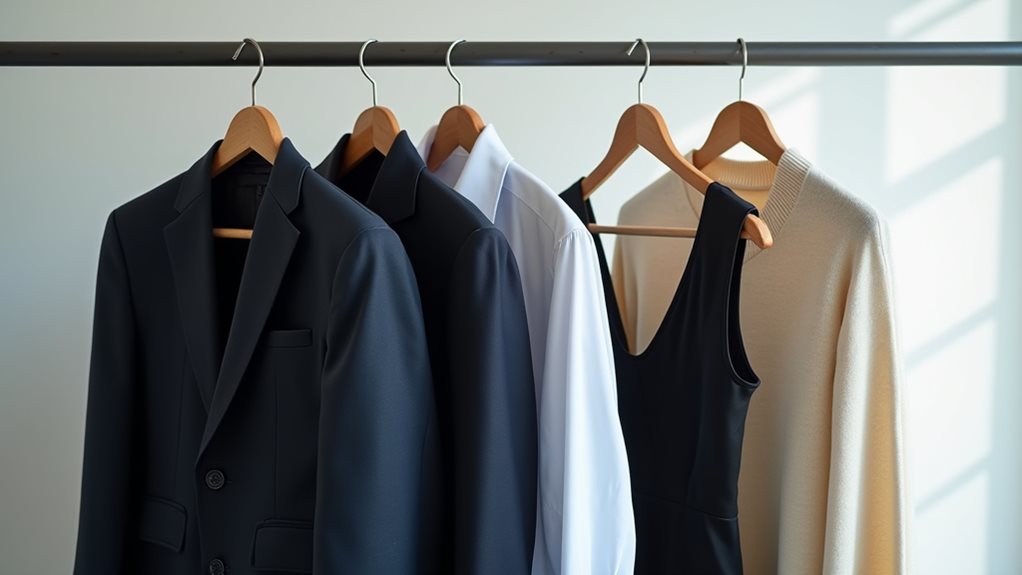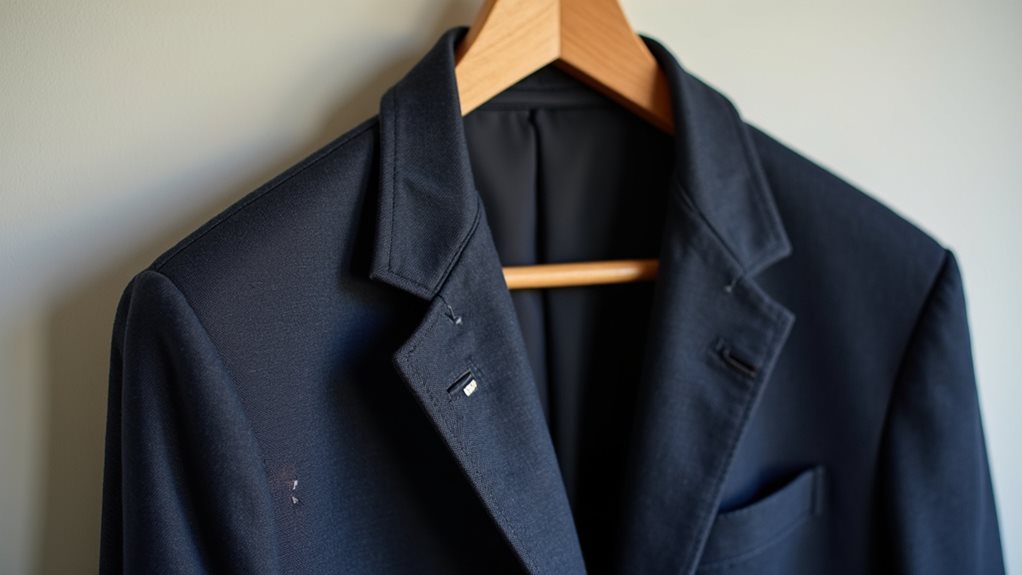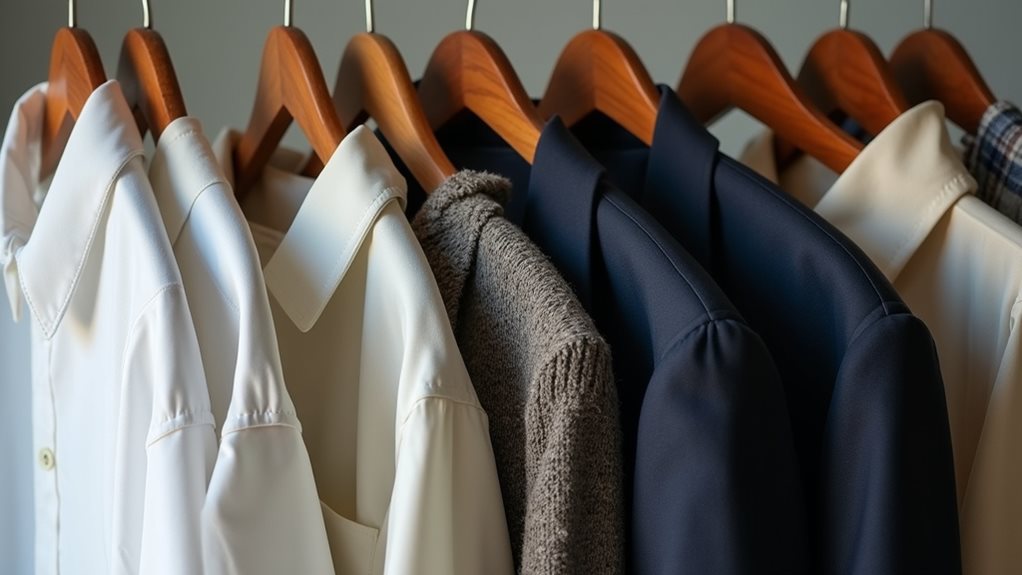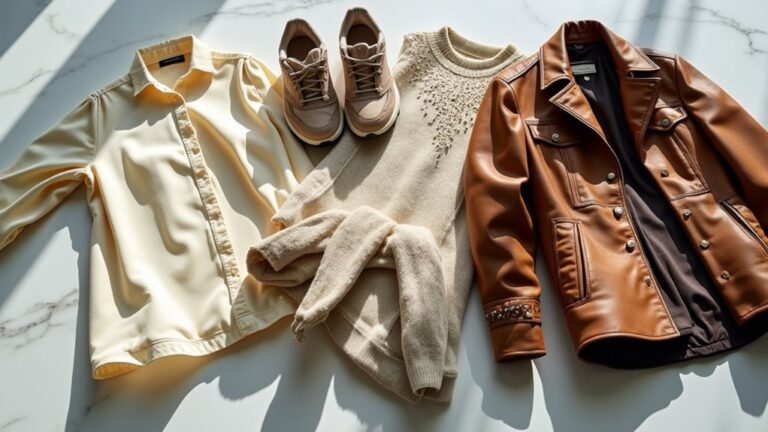You should dry clean wool suits every 3-5 wears, silk garments after just 1-2 wears, and cashmere pieces every 2-3 wears, though I’ve learned the hard way that environmental factors like summer heat, dining mishaps, and city grime can dramatically shorten these timelines. Synthetic blends are more forgiving at 4-6 wears, but always trust your nose and eyes—visible stains or odors mean it’s time, regardless of wear count, and understanding these nuances will help you protect your investment pieces properly.
Understanding Different Fabric Types and Their Cleaning Requirements
When I first started building my professional wardrobe, I honestly thought all suits were created equal—boy, was I in for a rude awakening 😅.
My biggest wardrobe mistake? Assuming expensive suits could handle the same treatment as my budget blazers.
Your wool suits can actually handle 3-5 wears before dry cleaning, thanks to their natural dirt-repelling superpowers, while delicate fabrics like silk demand attention every 1-2 wears to prevent permanent stains.
I learned this lesson when my gorgeous cashmere suits started looking shabby after ignoring their 2-3 wear cleaning requirements.
Synthetic blends are your workhorses, lasting 4-6 wears before needing professional care.
Environmental exposure changes everything though—when you wear your suit in humid, polluted conditions, the frequency of cleaning increases dramatically.
These delicate fabrics require professional dry cleaning because chemical solvents safely remove dirt without causing the shrinkage, color bleeding, or texture changes that water-based washing would inflict.
Understanding these fabric-specific cleaning requirements saves both your wardrobe and wallet.
General Guidelines for Common Clothing Items

Now that you’ve got the fabric fundamentals down, let’s talk about the real-world application—because honestly, I used to overthink every single garment until I developed these practical guidelines that actually work.
For cleaning your suit, stick to every three to five wears unless you’ve got obvious stains on your suit or it’s been through a particularly sweaty day.
Formal wear and delicate fabrics like silk need more attention—think every wear or two, especially for blouses that sit close to your skin.
Button-down shirts follow similar rules, while pants and skirts can handle about five wears before hitting the dry cleaning services.
The key is to properly care for each piece based on its exposure level and fabric needs.
Always check care labels first, as they provide the most reliable guidance on whether your specific garment requires professional dry cleaning or can be safely laundered at home.
Environmental Factors That Affect Cleaning Schedule

While those general guidelines give you a solid foundation, your environment can completely throw those neat little rules out the window—and trust me, I learned this the hard way when I moved from suburban quiet to downtown chaos and suddenly found myself at the dry cleaner twice as often.
Environmental exposure affects your frequency of dry cleaning more than you’d imagine. Urban pollution, commuting grime, and weather conditions create a perfect storm for fabric contamination. Your cleaning schedule needs flexibility based on these factors:
- Seasonal changes: Summer perspiration and humidity demand more frequent cleaning than winter’s forgiving dryness
- Personal habits: Restaurant dining, public transportation, and outdoor events introduce dirt and odors faster
- Weather conditions: Moisture absorption during rainy seasons accelerates the need for professional cleaning
When planning your cleaning frequency, consider choosing certified green cleaners that offer eco-friendly alternatives to traditional chemical solvents, which can be better for both your garments and the environment.
Adapt your routine accordingly!
Signs That Indicate Professional Cleaning Is Needed

Beyond understanding how your surroundings impact your cleaning routine, you’ll need to develop a keen eye for the telltale signs that scream “dry cleaner, now!”—and I promise you, ignoring these red flags will cost you more than just money when you’re standing in an important meeting wondering if everyone can smell what you can’t.
Visible stains are your suit’s cry for help, while unpleasant odors signal it’s time for professional cleaning, especially after that all-day outdoor event you powered through.
General wear and tear, soil buildup, and deterioration aren’t just cosmetic issues—they’re warnings that your investment needs immediate attention.
Don’t wait until adverse weather conditions or extended wear compromise your ability to maintain appearance through proper dry cleaning.
Keep in mind that stubborn sweat stains may require specialized pre-treatment or alternative cleaning methods, as traditional dry cleaning solvents have limited effectiveness against water-based perspiration marks.
Best Practices for Extending Time Between Cleanings

Before you resign yourself to weekly dry cleaning bills that rival your grocery budget, let me share the game-changing habits that’ll keep your suits looking sharp while your wallet stays happy.
These simple practices will extend time between those expensive trips to the cleaners every month:
- Brush regularly with a soft brush – I learned this from my grandfather, who’d carefully brush his suits after each wear, removing lint and dirt before they could settle into the fabric.
- Address spills immediately – Blot (don’t rub!) any liquid with a clean cloth to prevent stains from setting permanently.
- Use proper wooden hangers – Give your suits breathing room in the closet; cramped conditions create wrinkles that scream “professionally cleaned.”
- Allow suits to air out for 24 hours – This simple step helps refresh the fabric and prevents odors from building up between wears.
When you rotate your suits strategically, you’ll wear suits longer without looking disheveled, meaning you won’t need cleaners every few wears.
After each wear, let your suit rest and breathe by allowing it to air out completely before returning it to your closet rotation.




